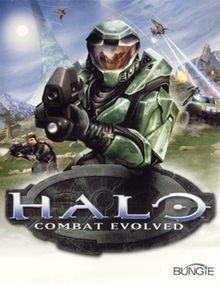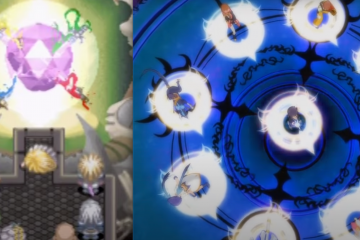
The following is part of Now Loading, a series that renders verdicts on whether or not your favorite video games deserve a place in the canon of works that have contributed to video-game storytelling in landmark ways. Read the series’ full mission statement here.
The Original Halo-Clone
Gentlemen and ladies, girls and boys, hello and welcome to Now Loading… The Video Game Canon! This is a friendly GUEST LECTURE from none other than me, some guy who isn’t Dan!
But really, I’m Nate, and I’m here to talk to you all about a game that is responsible for the success of the Xbox, and for far too many nights with friends and Doritos in high school: Halo: Combat Evolved. Just for full disclosure, this game and its prequels and sequels are my favorite multiplayer games: not only have they been a source of joy in my life for years, but they also have been foundational in many of my closest friendships.
Back in middle school, many of my friends would ride the school bus to each others’ houses at the end of the school day, pop a disk into the Xbox 360 and play for hours, before our parents all summoned us back to our own houses for dinner and school work. Almost always, Halo would be one of the games that we played, since we knew it would inevitably lead to epic cooperative gameplay, tense online matchmaking, and a lot of laughs constructing our own levels in Forge, the level editor. Some of my best memories are of these moments, bonding over Halo.
In high school this pattern continued, but in a more involved way. While running and gunning in Halo, my friends and I would talk about anything and everything for hours. It could have been anything from shooting the breeze to debating our emerging ideas about philosophy and life, which, as it turns out, guided us in the long-run towards our work here at With A Terrible Fate. Our lives unfolded against the backdrop of Halo multiplayer.
And now, even after college, with the Xbox 360 replaced years ago by the Xbox One, when I get together with friends from middle school, we’ll still pop in an old Halo game and run-and-gun our way through the nostalgic tight shooter that we remember so fondly.
And my Halo story is by no means uncommon. When the unstoppable Bungie developed Halo, the sales were astronomical; since the game wasn’t available on Sony’s PlayStation, it caused a surge in sales for Microsoft’s recently-developed Xbox. This multiplayer military sci-fi shooter single-handedly shook up the historic war between Nintendo and Sony for control over the console market. From 2001 on, the old duopoly controlling console gaming became the triopoly of Nintendo, Sony, and Microsoft, all vying for the top spot in that market.
All of this was because of Halo.
Lest you think that the market results I described are an anomaly, Halo in fact did a lot right, especially in terms of designing for multiplayer on the hardware of the day. To this day, sixteen years after the game’s release, there are still people playing the original Halo multiplayer, even though an entire generation of sequels, prequels, spin-offs, and clones have come and gone since. Halo, along with two other well-known titles, Call of Duty and Golden Eye, are responsible for not merely a style of games, but rather the entire genre of shooter games.
Jeez, why do we even need to ask if Halo should be canonized?
Well, let’s slow down a little bit and remember what our mandate is in Now Loading. From the game-development perspective and the multiplayer-gaming perspective, Halo‘s legacy has stood the test of time. It had immediate and lasting success, and its cultural impact is a major reason why Bungie is still the top dog at creating multiplayer games for the 18-40-year-old male market. (I’ll be discussing this further later in the article, as it’s crucial to understanding this game and its impact on society at large.) But Now Loading is specifically interested in the canon of work that has made essential contributions to the storytelling of video games.
So, the question we need to answer is this: even with Halo’s success in the industry, is it really a game that we need to play in order to understand video games and the way that they tell stories?
Let’s have at it.

Story and Characters: MASTER CHIEF Shoots Stuff
A super-soldier clad in the most grassy-green armor imaginable, Master Chief stole the hearts of every male age 8-20 who played Halo. He and his AI lady friend Cortana, who functions largely as something between narrator and MacGuffin for most of the game, are probably the most memorable parts of the story of the original Halo. Master Chief’s gruff, three-words-or-fewer responses to questions are somehow full of warmth and confidence that are magnetic for the relatively young audience that tended to play these games. His curtness was well-balanced by the more energetic voice of Cortana, who filled the role of actually telling players what the hell was going on from moment to moment.
This is a huge point in favor of the game: just how likable and fun the main characters are.
But although these characters are incredibly memorable and have made an indelible impact on gamer culture, I doubt that most of you who played this game back in the day could recount its story to me.

Ummmm… You shoot stuff, I guess?
That’s a problem. For reasons that will become clear later, the story in this game is simply not memorable, at least in comparison to the other things that the game has to offer. Most players took the main campaign of the game as an opportunity to run around and shoot at aliens, usually with their friends. The goal was to play a fun shooter, not so much to engage with the story. But, as it turns out, Halo does in fact have a surprisingly cool story, one that has spawned over a decade of further stories that flesh out its universe.
The game starts out during a war between humans, who have at this point spread throughout the galaxy, and a conglomeration of cultish aliens that have decided that the existence of humanity is a plague upon the universe. These aliens force the ship carrying Master Chief to crash-land onto a strange, ring-shaped satellite called “Halo.” Fast-forward a little bit, and it’s discovered that there are these parasitic beings called “the Flood” on the Halo rapidly infecting the universe.

It was the early 2000s: everything was about zombies.
Cortana and Master Chief find out that, conveniently, the Halo is actually a machine designed to destroy the Flood! But, when Master Chief is about to activate it, Cortana fortuitously learns that the Halo’s intended purpose is actually to destroy all sentient life in the universe, thereby “stopping” the Flood by depriving them of hosts through which to reproduce.
Oh, darn.
So instead of activating the Halo, Master Chief blows the whole damn thing up and escapes.
Not a bad bad story, right? I mean, not amazing, but hey, it’s decent.
You’ll notice, too, that in comparison to other games that Dan’s explored in Now Loading thus far, this story synopsis is shockingly concise. And that’s a huge positive for the game. As Dan’s discussed, many games overshoot in terms of story complexity. They end up telling a worse story because the player gets confused, either because there are too many details to keep track of, or because the details have been left out to make the game shorter. In contrast, Halo tells a relatively simple, relatively clear story—and one that has been the starting point for many more (much more complicated) stories. Even though Bungie’s delivery of the story might have had problems (we’ll get to that in a moment), they didn’t try to shoot the moon and end up crashing and burning.
The problem is that there’s no particular way in which Halo’s gameplay complements its story. From beginning to end, all you do is shoot stuff, often with friends. The game contains within it this very nice, concise story, but the gameplay itself does little-to-nothing to realize this story in a way that is memorable. The story would have been nearly as good if it was removed from the game itself, and just included as a novella within the box for the game (which might explain why Halo actually has been reimagined as a novel). You’ll notice that I have no complaints with either the story or the gameplay themselves, but there was not any emphasis on combining them in a creative way (except for the audio, but we’ll get there).
The disconnect between the story and the gameplay ended up having a subtle effect on the theming of the game. Instead of giving off a sense of gravity and importance, as the story of the game would suggest, Halo ended up having more of a Rambo-esque, run-and-gun, murder-spree feeling. The only way to make sense of the shooting-filled gameplay is to attribute it to the character of the already likable Master Chief. The game’s story really ends up being “Master Chief runs around and shoots stuff,” exactly because Master Chief, as the avatar, is the point of entry for players into the game, and all of the gameplay consists solely of running around and shooting stuff.
In order to drive home the story in a way that would have been memorable to players, the game’s mechanics would have had to change to support the themes of the story. But, in the absence of that, Halo ends up being more about Master Chief’s super-fun Rambo murder party than it is about ancient doomsday devices, a race of unstoppable zombie aliens, and saving the universe.
Gameplay, Music, and Visuals: Tight Gunplay and Choirs
Even though it doesn’t do much to enhance the story, the gunplay in Halo—its core gameplay mechanic—is simply phenomenal. From little UI touches like showing the amount of ammo left for certain guns on the gun itself, to the way that the needles from the needler explode if enough of them have hit an enemy, wielding the weapons in Halo simply felt awesome.
But what really drove the gameplay of Halo home was a very simple design choice: Master Chief can only carry two guns at any one time, and he can pick up any killed enemy’s gun. This forced the player to be like Rambo, running and gunning around the map, since ammo was scarce for any one gun that was picked up, and sometimes you had to get to an enemy’s position to take their weapon if it was better for your current situation than the one you were carrying.
If the goal was to feel like a biologically enhanced super-soldier, Bungie delivered on that goal in a hardcore way.
While the visuals may not hold up that well today, in 2001, they were simply splendid. The particle effects had pop, 3D environments actually looked like what they were supposed to look like, and, most importantly, this background was visible during large swaths of the game:

If you’re trying to make the player believe they are standing on a ring-shaped satellite, I’m not sure how you could sell it better.
That’s really what the visuals in Halo accomplished: the establishment of a sense of reality in a world very different from the one we know.
But where the game really shines is in its music direction—so much so that I’ve dedicated the entire “BONUS LEVEL” section to it, below. Stay tuned.
Impact on Video Gaming and Culture: Can I Possibly Overstate This?
Probably the single most important thing to recognize about Halo is that it changed the face of video-game multiplayer games irrevocably. From local cooperative play, to a wonky connection scheme that allowed you to link two Xboxes together for eight-person local multiplayer, Bungie executed Halo‘s multiplayer experience brilliantly.
Not only did they get multiplayer right the first time: they also continued to do so for an entire decade. Every few years, a new Halo title would come out, and Halo fans everywhere would dive into their basement, fire up the Xbox, and play Halo together until they passed out from sheer exhaustion.
And while the technology didn’t exist at the time of the first game’s release, Halo 3 ushered in an age of online matchmaking play that has completely revolutionized the way that people play multiplayer games. Suddenly developers were able to design multiplayer games that presumed that each player had their own dedicated system and screen and were connected to each other online. These systems are the backbone that have led us to an age where games like Overwatch are played the world over, by leveraging random matchmaking from consoles all over the planet.
And Halo’s innovations don’t stop there. The forging system introduced in Halo 3 taught much of my generation the joys of creating custom maps and game modes for those maps. This has since become the central mechanic of Minecraft, which is likely the single most popular video game among children under age 13 currently.

This sort of thing was pretty common to see in Forge.
While these particular achievements don’t belong to the first Halo, it’s still the case that this series has had a profound impact on gaming culture as a whole. So I give the original Halo high praise for serving as the backbone for the accomplishments of Bungie in the years after its release. We have Halo to thank for so much of the shooter multiplayer that we know and love today. And while Bungie has moved on to other projects, we should not forget the Halo series and how much it accomplished.
BONUS LEVEL: How to Prove the Value of Video Games with Only a Title Screen
It’s worth dwelling for a moment on the unique success that is the music of Halo: it goes beyond being just functional, and becomes superb. To understand why, let’s take a moment to consider what video game music had usually been like up until the release of Halo. The usual pattern tended to fall into one of two camps:
- Each level had a looped backing track that served as the “theme” for that level. Sometimes (in a game like Banjo Kazooie) that backing track would change depending on context, such as when the player stepped into the shade or fell into water.
- There was no music. The game was going for realism and so relied on sound effects only; otherwise, the game was silent.
Halo’s audio director, Martin O’Donnell, smartly avoided both of these camps, instead electing to create various loops that could be intermixed in random ways, depending on context. This allowed the soundtrack to achieve two things:
- It responded to the current level of action at any given moment in the game.
- It created ever-changing pieces of music that lasted for an indefinite period of time, even though, most of the time, there was minimal music playing.
The resulting soundscape felt incredibly epic for the player, who heard the music first start and then become more dramatic the more intense a fight got, but in a way that changed in pretty much every single fight.
And Bungie has chosen to continue this style in the long-run. Somehow, even after playing the same missions on repeat in Destiny, Bungie’s newest series, the music never gets stale. We have O’Donnell’s work on Halo to thank for that.
O’Donnell deserves a special shout-out for delivering on one of the pieces of music that convinces non-gamers to take video game music seriously, in the form of this marvelous piece that plays on the game’s title screen. Don’t think you can’t create a sense of gravitas just in a title screen.
VERDICT: The Closest “No” You Can Imagine
I’d like to return to an idea that I mentioned toward the start of this article: the failure of Halo’s story to interact with its gameplay. While the story literally deals with the fate of all life in the universe, all of the gameplay serves only one or two purposes.
- Feel like Rambo.
- Dick around with your friends.
And while Halo executes on both of those goals absolutely magnificently, in a way that I could not possibly overstate if I tried—in a way that has changed the entire course of gaming history—and the story is good to boot, the game does not succeed in connecting its gameplay to its story.
After playing through the story of the game, the player is far more likely to say, “Wow, I have no idea what happened but that was awesome,” than they are to say, “What a cool story!” And while this isn’t intrinsically a problem for the game, it means that, unfortunately, it does not deserve a place in the canon of video-game storytelling.

Sorry, Chief—not this time.



